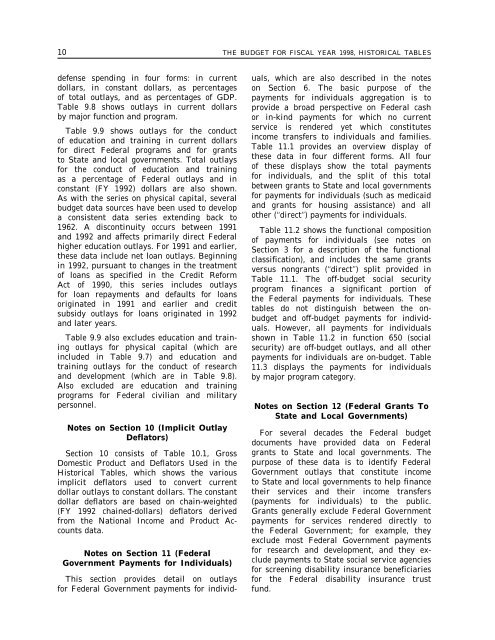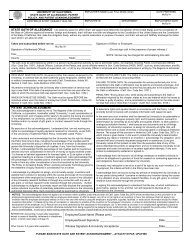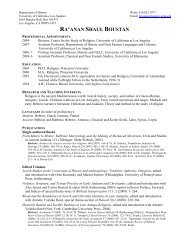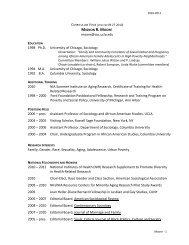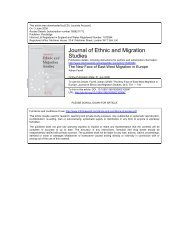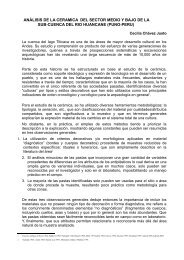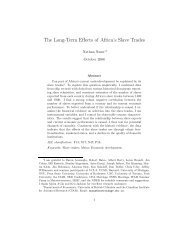EOP Historical Tables of the U.S. Budget - Social Sciences Division
EOP Historical Tables of the U.S. Budget - Social Sciences Division
EOP Historical Tables of the U.S. Budget - Social Sciences Division
Create successful ePaper yourself
Turn your PDF publications into a flip-book with our unique Google optimized e-Paper software.
10 THE BUDGET FOR FISCAL YEAR 1998, HISTORICAL TABLES<br />
defense spending in four forms: in current<br />
dollars, in constant dollars, as percentages<br />
<strong>of</strong> total outlays, and as percentages <strong>of</strong> GDP.<br />
Table 9.8 shows outlays in current dollars<br />
by major function and program.<br />
Table 9.9 shows outlays for <strong>the</strong> conduct<br />
<strong>of</strong> education and training in current dollars<br />
for direct Federal programs and for grants<br />
to State and local governments. Total outlays<br />
for <strong>the</strong> conduct <strong>of</strong> education and training<br />
as a percentage <strong>of</strong> Federal outlays and in<br />
constant (FY 1992) dollars are also shown.<br />
As with <strong>the</strong> series on physical capital, several<br />
budget data sources have been used to develop<br />
a consistent data series extending back to<br />
1962. A discontinuity occurs between 1991<br />
and 1992 and affects primarily direct Federal<br />
higher education outlays. For 1991 and earlier,<br />
<strong>the</strong>se data include net loan outlays. Beginning<br />
in 1992, pursuant to changes in <strong>the</strong> treatment<br />
<strong>of</strong> loans as specified in <strong>the</strong> Credit Reform<br />
Act <strong>of</strong> 1990, this series includes outlays<br />
for loan repayments and defaults for loans<br />
originated in 1991 and earlier and credit<br />
subsidy outlays for loans originated in 1992<br />
and later years.<br />
Table 9.9 also excludes education and training<br />
outlays for physical capital (which are<br />
included in Table 9.7) and education and<br />
training outlays for <strong>the</strong> conduct <strong>of</strong> research<br />
and development (which are in Table 9.8).<br />
Also excluded are education and training<br />
programs for Federal civilian and military<br />
personnel.<br />
Notes on Section 10 (Implicit Outlay<br />
Deflators)<br />
Section 10 consists <strong>of</strong> Table 10.1, Gross<br />
Domestic Product and Deflators Used in <strong>the</strong><br />
<strong>Historical</strong> <strong>Tables</strong>, which shows <strong>the</strong> various<br />
implicit deflators used to convert current<br />
dollar outlays to constant dollars. The constant<br />
dollar deflators are based on chain-weighted<br />
(FY 1992 chained-dollars) deflators derived<br />
from <strong>the</strong> National Income and Product Accounts<br />
data.<br />
Notes on Section 11 (Federal<br />
Government Payments for Individuals)<br />
This section provides detail on outlays<br />
for Federal Government payments for individuals,<br />
which are also described in <strong>the</strong> notes<br />
on Section 6. The basic purpose <strong>of</strong> <strong>the</strong><br />
payments for individuals aggregation is to<br />
provide a broad perspective on Federal cash<br />
or in-kind payments for which no current<br />
service is rendered yet which constitutes<br />
income transfers to individuals and families.<br />
Table 11.1 provides an overview display <strong>of</strong><br />
<strong>the</strong>se data in four different forms. All four<br />
<strong>of</strong> <strong>the</strong>se displays show <strong>the</strong> total payments<br />
for individuals, and <strong>the</strong> split <strong>of</strong> this total<br />
between grants to State and local governments<br />
for payments for individuals (such as medicaid<br />
and grants for housing assistance) and all<br />
o<strong>the</strong>r (‘‘direct’’) payments for individuals.<br />
Table 11.2 shows <strong>the</strong> functional composition<br />
<strong>of</strong> payments for individuals (see notes on<br />
Section 3 for a description <strong>of</strong> <strong>the</strong> functional<br />
classification), and includes <strong>the</strong> same grants<br />
versus nongrants (‘‘direct’’) split provided in<br />
Table 11.1. The <strong>of</strong>f-budget social security<br />
program finances a significant portion <strong>of</strong><br />
<strong>the</strong> Federal payments for individuals. These<br />
tables do not distinguish between <strong>the</strong> onbudget<br />
and <strong>of</strong>f-budget payments for individuals.<br />
However, all payments for individuals<br />
shown in Table 11.2 in function 650 (social<br />
security) are <strong>of</strong>f-budget outlays, and all o<strong>the</strong>r<br />
payments for individuals are on-budget. Table<br />
11.3 displays <strong>the</strong> payments for individuals<br />
by major program category.<br />
Notes on Section 12 (Federal Grants To<br />
State and Local Governments)<br />
For several decades <strong>the</strong> Federal budget<br />
documents have provided data on Federal<br />
grants to State and local governments. The<br />
purpose <strong>of</strong> <strong>the</strong>se data is to identify Federal<br />
Government outlays that constitute income<br />
to State and local governments to help finance<br />
<strong>the</strong>ir services and <strong>the</strong>ir income transfers<br />
(payments for individuals) to <strong>the</strong> public.<br />
Grants generally exclude Federal Government<br />
payments for services rendered directly to<br />
<strong>the</strong> Federal Government; for example, <strong>the</strong>y<br />
exclude most Federal Government payments<br />
for research and development, and <strong>the</strong>y exclude<br />
payments to State social service agencies<br />
for screening disability insurance beneficiaries<br />
for <strong>the</strong> Federal disability insurance trust<br />
fund.


